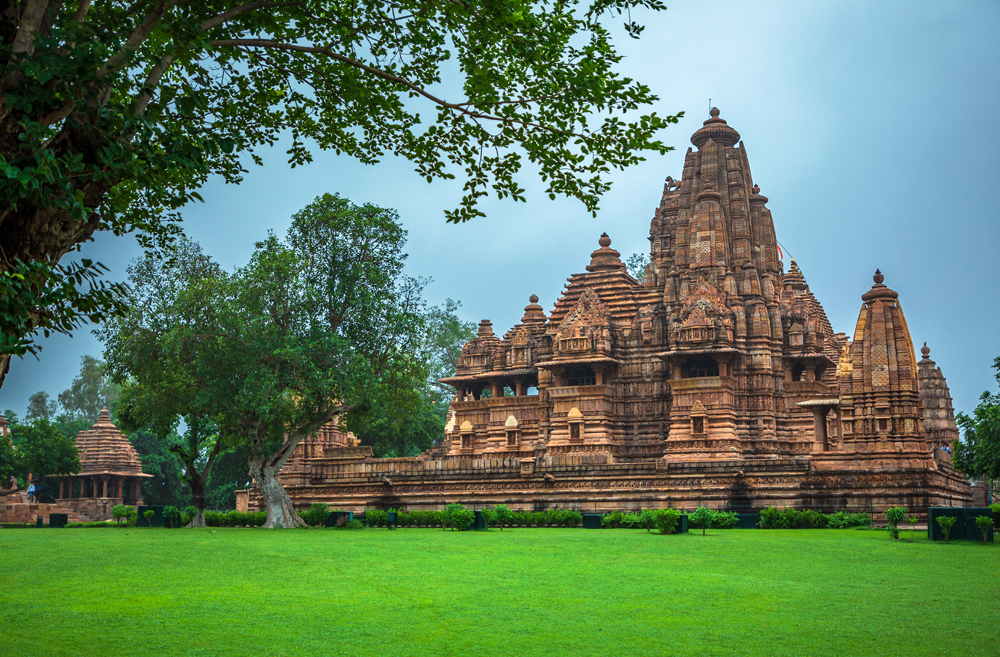Khajuraho, located in the Chhatarpur district of Madhya Pradesh, is a UNESCO World Heritage site renowned for its stunning group of ancient temples adorned with intricate and elaborate sculptures. The temples of Khajuraho are a testament to the artistic and architectural achievements of the Chandela dynasty, showcasing a unique blend of religion, art, and sensuality. Here’s a closer look at what makes Khajuraho a captivating and culturally significant destination:
Temple Complex: The Khajuraho Group of Monuments comprises a collection of intricately carved temples, each dedicated to various Hindu deities and representing different architectural styles.
Exquisite Sculptures: The temples are adorned with thousands of sculptures that depict a range of themes, including gods and goddesses, mythical creatures, celestial nymphs, animals, dancers, and more.
Sensuous Carvings: While Khajuraho is often associated with its sensuous sculptures, these depictions are just a small fraction of the overall carvings. They are a reflection of the all-encompassing nature of life, including spiritual and earthly aspects.
Spiritual Significance: The temples hold deep spiritual significance, with intricate carvings illustrating scenes from Hindu epics like the Mahabharata and Ramayana, as well as themes of meditation, devotion, and divine worship.
Architectural Marvel: The architecture of the temples showcases the unique Nagara style, characterized by soaring spires, intricate carvings, and symbolic elements that hold spiritual meanings.
Western Group of Temples: The Western Group of Temples is the most famous and well-preserved cluster, featuring notable temples like the Kandariya Mahadeva Temple, Lakshmana Temple, and Devi Jagadambi Temple.
Sound and Light Show: Attend the captivating Sound and Light Show held in the temple complex, where the history of Khajuraho and its temples is narrated against the backdrop of illuminated temples.
Sculpture Museum: Explore the Archaeological Museum located nearby, which houses a collection of sculptures and artifacts found in the region, providing insights into the history and craftsmanship of Khajuraho.
Khajuraho Dance Festival: If you visit during February, you can experience the annual Khajuraho Dance Festival, where classical Indian dance forms are performed against the backdrop of the temples.
Village Life: Immerse yourself in the local village life surrounding Khajuraho, interacting with the friendly residents and experiencing rural traditions.
UNESCO World Heritage: The temples of Khajuraho were designated a UNESCO World Heritage site in recognition of their cultural and historical significance.
Symbolism and Philosophy: Delve into the symbolism and philosophy behind the temple carvings, as they depict aspects of life, spirituality, and the pursuit of higher consciousness.
Photography: Capture the intricate carvings and architectural details of the temples, creating a visual record of their exquisite artistry.
Yoga and Meditation: Find moments of tranquility amidst the temple complex, engaging in yoga or meditation to connect with the spiritual energy of the surroundings.
Archaeological Interest: Khajuraho’s temples have attracted archaeologists, historians, and scholars interested in understanding the artistic and cultural heritage of the region.
Global Recognition: The temples have gained international acclaim for their artistic and architectural significance, drawing visitors from around the world.
Cultural Heritage: Khajuraho’s temples are a testament to India’s rich cultural heritage and serve as a symbol of the country’s artistic accomplishments.
Awe-Inspiring Beauty: Marvel at the sheer beauty of the intricate carvings, which tell stories and convey emotions through the medium of stone.
Khajuraho stands as a captivating destination where art, spirituality, and history converge. As you explore the temple complex and its timeless sculptures, you’ll gain a deeper appreciation for the craftsmanship of the past and the enduring legacy of artistic expression.

